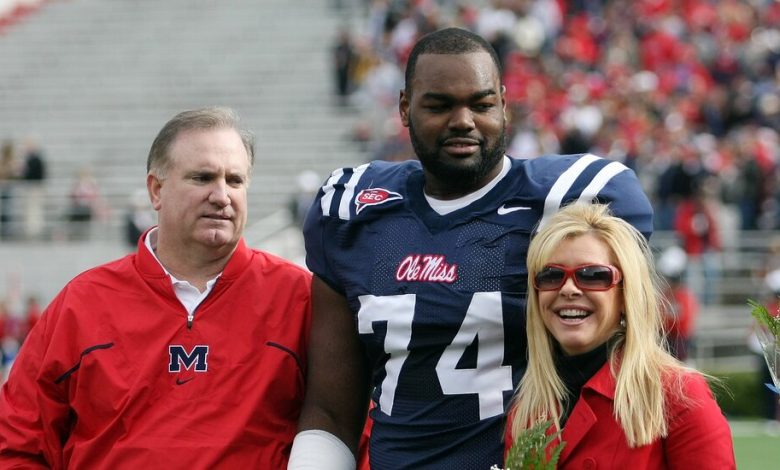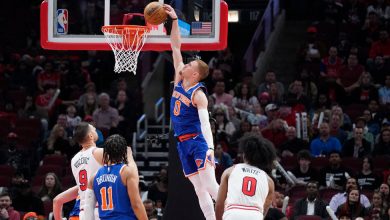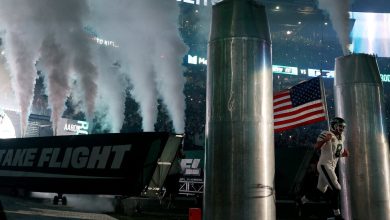The Blind Side of Sports Storytelling


Michael Oher, center, filed a lawsuit against Sean Tuohy, left, and Leigh Anne Tuohy, right, over their conservatorship of his business affairs.Credit…Matthew Sharpe/Getty Images
Of course America loved “The Blind Side,” the 2009 movie about a homeless and hapless Black teenager rescued from a bleak future by a wealthy, white family. It was based on the true story of the Tuohy family, led by Sean and Leigh Anne, who took the future N.F.L. player Michael Oher into their home and raised him proudly as he made it to college and beyond.
It’s the type of story we’re used to in sports, one that undergirds our beliefs about sport’s power to create lifelong bonds, help its participants overcome hardships, and build character. It’s also a simplified rendering of race in America, one that hinges on the trope that white people can be magically redeemed by coming to the aid of a Black character.
Audiences sucked it up. The film took in over $300 million and Sandra Bullock won an Oscar for her portrayal of Leigh Anne Tuohy, self-possessed belle of the New South.
But “The Blind Side,” based on the best-selling book by Michael Lewis, renders a complicated reality in the most digestible format. This week, surprising news of a lawsuit filed by Oher against the Tuohys spurred many to reconsider the movie, searching for answers to questions raised by the legal claim and obscured by the film’s comfortable, tidy narrative.
Oher is suing the couple for a full accounting of their relationship. He claims that when he thought he was being adopted at 18, the Tuohys urged him to sign a conservatorship that gave them control to enter into contracts on his behalf. He says that the familial bond, warmly portrayed in the movie, was a lie and that the Tuohys enriched themselves at his expense.
The Tuohys have defended their actions, arguing in a statement that the conservatorship was a legal necessity so Oher could play football at the University of Mississippi without jeopardizing his eligibility.
In a story with at least four versions — that of Lewis, the movie studio, Oher and the Tuohys — it’s almost impossible to discern who is telling the truth.
Until this week, I must admit, I had never seen “The Blind Side.” I’d purposefully avoided it. I’m leery of movies that lean on simple racial clichés — a fatigue that began as a child, when so many of my Black heroes died at the end of films so white heroes could live.
News of Oher’s lawsuit convinced me that it was time to plop down on the couch and take in the film, with the benefit of 14 years of hindsight — 14 years in which race and sports have re-emerged as essential platforms for the examination of America’s troubles.
My assumptions were proved correct early in the film, while Oher’s character was taking shape. As the story unfolds, he is shown as a lost cause before meeting the Tuohys and attending a well-to-do Christian school in Memphis. The film portrays him in easy terms: as a body, first and foremost — a gargantuan Black teen whose I.Q., we are told, is low, and who has no idea whatsoever about how life operates in worlds that are not swamped in poverty and despair.
The Oher of the film, particularly early on, has little agency and no real dreams of his own. When I saw that, it felt like a gut punch. “What?” I muttered. “There’s no way this characterization is true.”
The Baltimore Ravens selected Oher in the first round of the 2009 N.F.L. draft. No one makes it that far in sports without a foundation of years of motivation and training, which gives credence to Oher’s long-held criticism of his portrayal in the film. He is an intelligent person, Oher has said, again and again, and he was a skilled football player well before meeting the Tuohys.
Not someone who needed the Tuohys’ young, pint-size son, Sean Jr., to teach him the game in the easiest of terms — by using bottles of condiments to show formations and plays. We watch Sean Jr. at a park, delighting in putting a clueless Oher through workouts.
The movie also shows the Tuohys using sports as a vehicle for Oher to develop confidence, enter a world of prestige and riches — and eventually to attend Ole Miss, the couple’s alma mater, where Sean Tuohy once starred in basketball.
Oher protects Leigh Anne Tuohy when they dare to go to the neighborhoods where he’d grown up — “That horrible part of town,” she says. He saves Sean Jr.’s life when the two are in a car crash by using his massive arm to shield the young boy from the force of an airbag. When Oher struggles on the practice field as he learns the game, Leigh Anne Tuohy bounds from the sidelines and drills him with firm instruction: He must shield the quarterback the same way he guarded her and her son.
“Protect the family,” she insists.
A lesson delivered to Oher by a feisty white woman as if he were a first-grader (or a servant) is a turning point. Oher begins transforming from a football neophyte raised on the streets into an offensive lineman with the strength of Zeus, the nimbleness of Mikhail Baryshnikov and the size of an upright piano.
Soon, we watch him play in a game, enduring aggressive and racist taunting from an opponent who initially has his way with an inexperienced rival.
Suddenly, Oher snaps. He does not just block the opposing player: Enraged, Oher lifts him and drives him across the field and over a fence.
“Where were you taking him, Mike?” his coach asks as Oher stands on the sidelines.
“To the bus,” Oher deadpans, his tone innocent and childlike. “It was time for him to go home.”
By the film’s end, the transformation is complete. We learn that under the watch of a wealthy white family, Oher’s I.Q. has improved to an average level! We see him become a high school champion! We watch a parade of coaches — real coaches, playing themselves in the film — fawn over Oher as they try to persuade him to suit up for their school.
It is hard to figure out, by the movie’s telling, Oher’s motivation, or his savvy, because he continues to be portrayed as a prop — quiet, docile, a young man who, for the most part, does as his newfound family says. This, by the way, makes it hard to even figure out, all these years later, the truth of his lawsuit.
What we do see in the movie is that he shines in college and the pros. There he is in the N.F.L., in his Baltimore Ravens gear. He had made it to the sports Promised Land and through it all, the Tuohy family was at his side.
This film had everything.
The dumbed-down trope about race and class in America that Hollywood has always peddled.
The simplified narrative that uncritically hails sport and its purity, the way it can change lives, always for the better, by shaping diamonds in the rough into jewels. The shadowy side of sports — the cheating, the lies, the broken promises, which, in this legal tussle, could be coming from either side — never encroach on the fairy tale.




